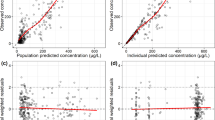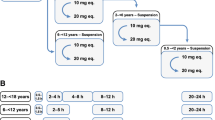Abstract
Introduction
Edoxaban is a novel factor Xa inhibitor. This study characterizes the population pharmacokinetics of edoxaban in patients with non-valvular atrial fibrillation (NVAF) included in the phase III ENGAGE AF-TIMI 48 study, evaluates covariates for the dose–exposure relationship in this population, and assesses the impact of protocol-specified dose reductions on exposure using simulations.
Methods
Model development was performed using NONMEM® and based on sparse data from the ENGAGE AF-TIMI 48 study augmented with dense data from 13 phase I studies to inform and stabilize the model. The influence of body weight (WT), creatinine clearance (CLCR), concomitant P-glycoprotein (P-gp) inhibitors, age, sex, race, and NVAF on pharmacokinetic parameters was evaluated based on statistical significance and clinical relevance.
Results
A two-compartment model with first-order elimination and first-order absorption after an absorption lag-time best described the data. Apparent volume and clearance terms increased with increasing WT. Apparent renal clearance increased with increasing CLCR. Apparent non-renal, renal, and inter-compartmental clearance terms differed between phase I volunteers and NVAF patients. Asian patients were found to have increased apparent central volume of distribution, bioavailability, and total apparent clearance. Concomitant P-gp inhibitors increased the bioavailability statistically significantly, but this did not reach clinical relevance.
Conclusion
Edoxaban disposition and the variability in this disposition, including influence of covariates, after oral administration were adequately characterized in patients with NVAF. The 50 % dose reduction in patients with low WT (≤60 kg), moderate renal impairment (CLCR ≤50 mL/min), or concomitant P-gp inhibitors led to 30 % lower exposure than in the other patients.




Similar content being viewed by others
References
Ansell J. Factor Xa or thrombin: is factor Xa a better target? J Thromb Haemost. 2007;5(Suppl 1):60–4.
Furugohri T, Isobe K, Honda Y, Kamisato-Matsumoto C, Sugiyama N, Nagahara T, et al. DU-176b, a potent and orally active factor Xa inhibitor: in vitro and in vivo pharmacological profiles. J Thromb Haemost. 2008;6:1542–9.
Salazar DE, Mendell J, Kastrissios H, Green M, Carrothers TJ, Song S, et al. Modelling and simulation of edoxaban exposure and response relationships in patients with atrial fibrillation. Thromb Haemost. 2012;107(5):925–36.
Yamashita T, Koretsune Y, Yasaka M, Inoue H, Kawai Y, Yamaguchi T, et al. Randomized, multicenter, warfarin-controlled phase II study of edoxaban in Japanese patients with non-valvular atrial fibrillation. Circ J. 2012;76(8):1840–7.
Ridout G, de la Motte S, Niemczyk S, et al. Effect of renal function on edoxaban pharmacokinetics (PK) and on population PK/PK–PD model [abstract no. 144]. J Clin Pharmacol. 2009;49:1124.
Mendell J, Zahir H, Matsushima N, Noveck R, Lee F, Chen S, et al. Drug–drug interaction studies of cardiovascular drugs involving P-glycoprotein, an efflux transporter, on the pharmacokinetics of edoxaban, an oral factor Xa inhibitor. Am J Cardiovasc Drugs. 2013;13(5):331–42.
Ruff CT, Giugliano RP, Antman EM, Crugnale SE, Bocanegra T, Mercuri M, et al. Evaluation of the novel factor Xa inhibitor edoxaban compared with warfarin in patients with atrial fibrillation: design and rationale for the Effective aNticoaGulation with factor xA next GEneration in Atrial Fibrillation-Thrombolysis In Myocardial Infarction study 48 (ENGAGE AF-TIMI 48). Am Heart J. 2010;160(4):635–41.
Giugliano RP, Ruff CT, Braunwald E, Murphy SA, Wiviott SD, Halperin JL, et al. ENGAGE AF-TIMI 48 Investigators. Edoxaban versus warfarin in patients with atrial fibrillation. N Engl J Med. 2013;369(22):2093–104.
Ruff CT, Giugliano RP, Braunwald E, Morrow DA, Murphy SA, et al. Association between edoxaban dose, concentration, anti-Factor Xa activity, and outcomes: an analysis of data from the randomised, double-blind ENGAGE AF-TIMI 48 trial. Lancet. 2015;385(9984):2288–95.
Cockcroft DW, Gault MH. Prediction of creatinine clearance from serum creatinine. Nephron. 1976;16(1):31–41.
Matsushima N, Lee F, Sato T, et al. Bioavailability and safety of the factor Xa inhibitor edoxaban and the effects of quinidine in healthy subjects. Clin Pharmacol Drug Dev. 2013;2:358–66.
Oguma T, Masumoto H, Yoshigae Y, et al. LC-MS/MS bioanalytical method for the determination of edoxaban in human plasma [abstract no. R6377]. AAPS J. 2010;S2.
Beal S, Sheiner L, Boeckmann A. NONMEM users guides. Ellicott City: ICON Development Solutions; 1989–2006.
Keizer RJ, Karlsson MO, Hooker A. Modeling and simulation workbench for NONMEM: tutorial on Pirana, PsN, and Xpose. CPT Pharmacometrics Syst Pharmacol. 2013;2:e50.
Beal SL. Ways to fit a PK model with some data below the quantification limit. J Pharmacokinet Pharmacodyn. 2001;28(5):481–504.
Niebecker R, Jönsson S, Karlsson MO, Miller R, Nyberg J, Krekels EH, et al. Population pharmacokinetics of edoxaban in patients with symptomatic deep-vein thrombosis and/or pulmonary embolism-the Hokusai-VTE phase 3 study. Br J Clin Pharmacol. 2015;80(6):1374–87.
Bergstrand M, Hooker AC, Wallin JE, Karlsson MO. Prediction-corrected visual predictive checks for diagnosing nonlinear mixed-effects models. AAPS J. 2011;13(2):143–51.
Yin OQ, Tetsuya K, Miller R. Edoxaban population pharmacokinetics and exposure–response analysis in patients with non-valvular atrial fibrillation. Eur J Clin Pharmacol. 2014;70(11):1339–51.
Rohatagi S, Mendell J, Kastrissios H, Green M, Shi M, Patel I, et al. Characterisation of exposure versus response of edoxaban in patients undergoing total hip replacement surgery. Thromb Haemost. 2012;108(5):887–95.
Song S, Kang D, Halim AB, Miller R. Population pharmacokinetic-pharmacodynamic modeling analysis of intrinsic FXa and bleeding from edoxaban treatment. J Clin Pharmacol. 2014;54(8):910–6.
Jönsson S, Simonsson US, Miller R, Karlsson MO. Population pharmacokinetics of edoxaban and its main metabolite in a dedicated renal impairment study. J Clin Pharmacol. 2015;55(11):1268–79.
Daiichi Sankyo Inc.; The TIMI Study Group. Global study to assess the safety and effectiveness of edoxaban (DU-176b) vs standard practice of dosing with warfarin in patients with atrial fibrillation (EngageAFTIMI48) [ClinicalTrials.gov identifier NCT00781391]. US National Institutes of Health, ClinicalTrials.gov. https://www.clinicaltrials.gov. Accessed 9 Feb 2016.
Acknowledgments
This study was sponsored by Daiichi Sankyo Pharma Development. The authors would like to thank Dr. J. Nyberg for supporting this analysis and Quintiles Inc. for the generation of the NONMEM® dataset.
Author information
Authors and Affiliations
Corresponding author
Ethics declarations
Conflict of interest
Mats Karlsson and Ulrika Simonsson have obtained consultancy fees from Daiichi Sankyo Pharma Development. Christian Ruff has served as a consultant and received honoraria from Daiichi Sankyo. Raymond Miller and Takako Shimizu are employees of Daiichi Sankyo. The other authors have no conflicts of interest to declare.
Electronic supplementary material
Below is the link to the electronic supplementary material.
Rights and permissions
About this article
Cite this article
Krekels, E.H.J., Niebecker, R., Karlsson, M.O. et al. Population Pharmacokinetics of Edoxaban in Patients with Non-Valvular Atrial Fibrillation in the ENGAGE AF-TIMI 48 Study, a Phase III Clinical Trial. Clin Pharmacokinet 55, 1079–1090 (2016). https://doi.org/10.1007/s40262-016-0378-3
Published:
Issue Date:
DOI: https://doi.org/10.1007/s40262-016-0378-3




